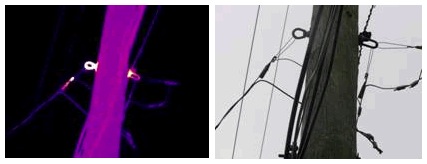Tip of the Week Archive
Detecting Open Neutrals and Hot Ground Conductors
Sponsored by:

Detecting Open Neutrals and Hot Ground Conductors
Infrared imaging is a proven technology for detecting hot spots caused by loose or deteriorated electrical connections. It is also capable of detecting hot components associated with open neutral conductors.
Basic principles state that electricity travels in a loop and needs a return path. Whether the electrical system is residential, commercial, or utility, this same principle applies. Therefore, one should see “outgoing” current flow on the main feed conductor and “return” current flow on the neutral conductor when measured with an ammeter. If the neutral conductor becomes open as a result of a failed connection or broken conductor, the return current is rerouted from the neutral pathway to a grounded object.
Common problems experienced with an open neutral are lights that burn dimmer on some circuits and others that burn brighter on other circuits. Also common are lights that flicker or turn brighter when heavy loads are applied, such as an air conditioning unit turning on.
Infrared imaging is an excellent tool for locating open neutral problems, especially for utility clients. The images below were captured during a periodic infrared scan of an overhead distribution feeder. The image shows an eyebolt anchor on a neutral line with a temperature rise of over 65 Fahrenheit (36 C) degrees. Not only did the discovery of this problem save unknown amounts of time to locate, it also prevented possible serious injury to an unsuspecting utility worker.

Having an open neutral is a dangerous situation that should be corrected as soon as possible. With an open neutral, the grounding conductor becomes energized and can cause injury to someone coming in contact with any bare metal that is intended to be at ground potential.
In most cases, open neutral problems experienced in residential and commercial buildings can be traced back to the utility’s side of the power system. This makes sense since utility connections are far more exposed to outdoor elements that can cause breaks and failures to conductor connections.
Tip Provided by:
Brady Infrared Inspections
935 Pine Castle Court
Stuart, FL 34996
Office: 772-288-9884
Advertisement

